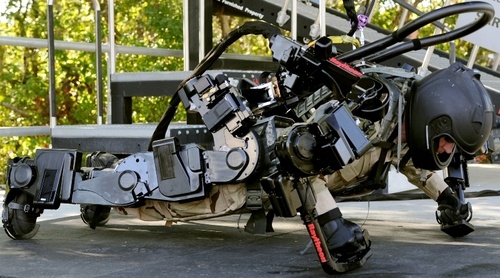Neuroscientists create the first brain-controlled exoskeleton that allow you to control a super-powered exoskeleton using only your thoughts.With the aid of brain-controlled devices, paralyzed people have been able to send e-mail, play video games, and operate robotic arms.
Scientists at the University of Chicago were experimenting with brain-computer interfaces in monkeys, teaching them to control computer cursors via electrodes implanted in their brains. We’ve known for a while that thinking about moving activates the same areas of the brain as moving itself does – so monkeys (and humans) learn to do this by imagining that they’re moving left, right, up or down. But the researchers discovered that the monkeys learned much faster if their arms were moved at the same time the cursor did – basically, they got feedback via movement in their bodies as well as from looking at the monitor.
According to the study from the Society for Neuroscience:
The authors worked with two adult rhesus macaques to assess a system that incorporates a sense of movement. Each monkey was first trained to control a cursor using brain signals only; electrodes collected and processed data from the monkeys’ motor cortex cells and transmitted those commands to the computer. Basic science research has shown that simply thinking about a motion activates brain cells in the same way that making the movement does, so each monkey needed to only think about moving a cursor to do it.
The researchers equipped each animal with a robotic “sleeve” that fit over an arm. In the first part of the experiment, the monkeys controlled the cursor by simply looking at the computer screen. In the second part, the robotic device moved the monkey’s relaxed arm in tandem with the cursor movement, so the monkey could sense the cursor’s motion in time and space. The authors found when the monkeys had the extra sensation, the cursor hit the target faster and more directly. The results also showed increased movement-related information in the activity of motor cortex cells, compared with visual-only feedback.
[Lead researcher Nicholas] Hatsopoulos said his group’s findings may pave the way for enhanced brain-controlled devices that include multiple forms of natural or even artificially produced sensory feedback. “Wearable exoskeletal robots could provide sensory information to patients with full or partial feeling,” he said. “Alternatively, direct stimulation of the relevant area of the cortex could be used to replicate sensory feedback in patients who have lost both motor and sensory function.”
The Journal of Neuroscience is published by the Society for Neuroscience, an organization of more than 40,000 basic scientists and clinicians who study the brain and nervous system.
Thanks to io9 via Society for Neuroscience


